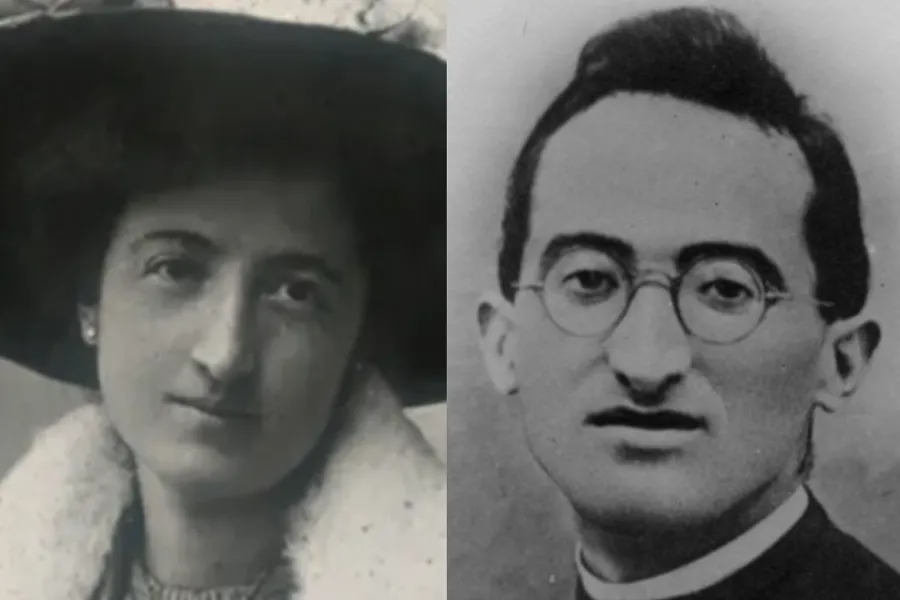Faith-Based Feminism Pioneer and Tireless Wartime Catholic Priest Beatified Together in Italy
Among those present at the beatification was Raffaella Di Grigoli, who was healed through Ciceri’s intercession more than 40 years ago when she was seven years old.

A pioneer of faith-based feminism and a Catholic priest who ministered tirelessly during the Second World War were beatified at Milan Cathedral over the weekend.
Armida Barelli and Father Mario Ciceri are now among those whom the Catholic Church has officially declared “blessed.”
Cardinal Marcello Semeraro, the prefect of the Vatican Congregation for the Causes of Saints, presided over the solemn rite of beatification on April 30 with more than 100 priests concelebrating and 1,800 people in attendance.
“In these stories of holiness: humble and hidden like that of Blessed Mario Ciceri, or public and well-known like that of Blessed Armida Barelli, the power of the Holy Spirit … is forever made manifest,” Semeraro said in his homily.
The cardinal highlighted how Ciceri found holiness in his vocation to be a priest, while Barelli’s path to holiness was through “the vocation to the lay apostolate.”
Among those present at the beatification was Raffaella Di Grigoli, who was healed through Ciceri’s intercession more than 40 years ago when she was seven years old.
As a child, Di Grigoli underwent a series of surgeries in 1975 for intestinal problems in her hometown of Como, northern Italy, and was feared to be near death.
The girl’s aunt organized a novena and told Ciceri’s sister about her niece’s plight. The sister gave the family a scarf that belonged to the priest.
Raffaella’s mother took the scarf to the hospital and placed it several times on her daughter’s body. Di Grigoli was discharged from the hospital on Feb. 4, 1976, and gave birth to a healthy girl in 2005.
The liturgical memorial of Ciceri will be celebrated locally on June 14 and Barelli’s on Nov. 19.
Archbishop Mario Delpini of Milan said at the end of the Mass that he had personally made the decision to celebrate his “name day” on Ciceri’s memorial instead of that of his patron saint, St. Mario.
Blessed Mario Ciceri
Mario Ciceri was born to poor farmers in northern Italy in 1900.
From childhood, he knew he had a vocation to the priesthood. With the permission of his devout parents, he left to study at a seminary high school while still in grade school. His achievements earned him scholarships, which allowed him to continue his studies despite his family’s limited means.
He was ordained a priest of the Milan archdiocese at age 23.
As a new priest, he was responsible for the parish’s catechism classes and helped with the Catholic Action youth group. He founded and directed a schola cantorum for young people.
Ciceri also helped to repair the buildings, acting as a carpenter, bricklayer, and electrical engineer. He used these skills to build a small reproduction of the Lourdes Grotto.
One young man at the parish wrote that the priest somehow found time to do these activities while also never neglecting his priestly ministry and was “always in church.”
The man said: “Yet if you go to the hospital, you can find him there at any time; if you go around the country, wherever there is a material or spiritual need, a pain to soothe, a need to help, you will find him there. Where you are sure not to find him is at his home, which really is not his home, but that of the young people.”
Ciceri cared for and encouraged the poor, the sick, former prisoners, and the young men who were soldiers fighting at the front during World War II.
In February 1945, while riding his bicycle home from a neighboring parish, where he had helped to hear confessions, he was hit by a buggy and fatally injured. He died two months later, on April 4, at the age of 44, after offering his suffering for an end to World War II and the safe return of soldiers.
Pope Francis called Ciceri “a shining example of a pastor” at the end of his Regina Coeli address on May 1.
Blessed Armida Barelli
Born to an upper-class family in Milan in 1882, Barelli came of age at a time when Italy’s first secular feminists emerged from the women’s suffrage movement, adding calls for divorce rights and more non-religious schools to their campaigns.
She served as president of the National Girls Youth of Catholic Action for more than three decades, helping young women to be formed in “a Eucharistic spirituality” and to recognize their equal “baptismal dignity” with men, according to the vice postulator for her sainthood cause, Ernesto Preziosi.
Under the spiritual guidance of Franciscan Father Agostino Gemelli, Barelli discerned a lay vocation as a Third Order Franciscan in 1910.
Cardinal Andrea Ferrari of Milan, who was himself later declared blessed, asked her to help found the city’s Catholic women’s chapter of Catholic Action.
Barelli met with Pope Benedict XV in 1918 for a private audience in which he appointed her as president of the National Girls Youth of Catholic Action.
She went on to help found the Catholic University of the Sacred Heart in Milan, collected a fund to open an orphanage in northern China, and founded the Secular Institute of the Missionaries of the Kingship of Christ together with Father Gemelli.
She died in 1952 after suffering for three years from a progressive chronic illness. Barelli’s cause for canonization was opened by the Archdiocese of Milan in 1960.
Pope Francis wrote a preface to a biography of Barelli that was published earlier this year.
“The Church now points to her as a model of a woman who in her own humanity, with the intelligence and gifts that God gave her, was able to bear witness to God’s love,” the Pope wrote.
- Keywords:
- congregation for the causes of saints














